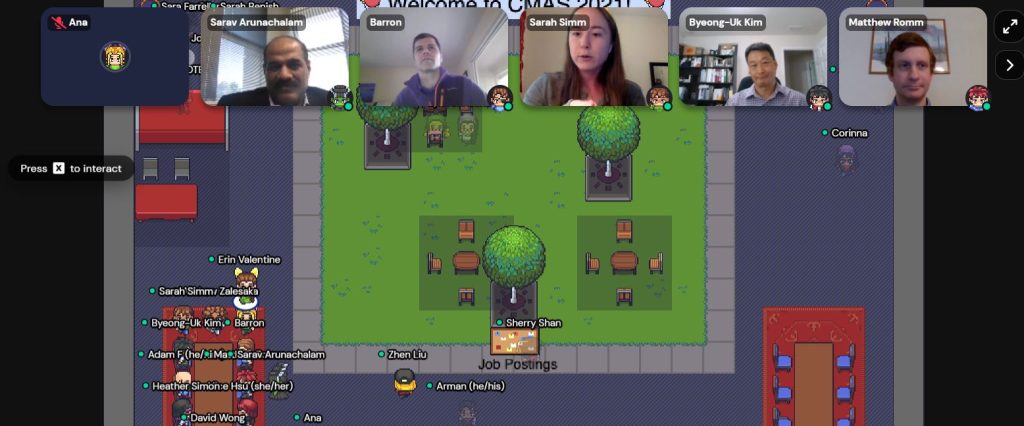CMAS Conference celebrates 20th anniversary with record attendance at 2021 virtual event in November
December 17, 2021
The Community Modeling and Analysis System (CMAS) Conference at the UNC Institute for the Environment held its 20th annual event Nov. 1-5, 2021 with a record number of registrants representing 19 countries and more than 360 attendees. This is the second year the conference has been held virtually due to public health concerns of the COVID-19 pandemic.
“This marks a milestone in collaboration and innovation that benefits society,” said Mike Piehler, director of the UNC Institute for the Environment, in his opening remarks at the conference. “One nice thing about this pivot to a virtual world has been the ability to expand accessibility to a range of areas that might not have been possible in the past.”
Attendees came from academia, industry, consulting groups and state and federal governments from across the world to discuss the latest research, applications and policies related to air quality. The event is internationally recognized and is the premier gathering for air quality scientists to share research and ideas on the state of the science. The CMAS Center has been hosted by the UNC Institute for the Environment since 2003 through successive cooperative agreements and contracts with the U.S. Environmental Protection Agency (EPA).
This year’s keynote address was delivered by Chris Frey, deputy assistant administrator for science policy in the Office of Research and Development at the U.S. Environmental Protection Agency. His remarks addressed high-resolution air quality modeling needs to support environmental justice.
Sarav Arunachalam, director of the Center for Environmental Modeling for Policy Development and deputy director of the UNC Institute for the Environment, provided an update on the state of the CMAS Center and a reflection on the last 20 years of the CMAS Center operations, which has seen tremendous growth over the last two decades. Demand for meetings abroad is evidenced by CMAS’s expansion to South America and Asia in previous years, but due to the global pandemic, plans have been temporarily halted. Arunachalam, who also serves as the director of the CMAS Center said the CMAS team and advisory board continue to monitor the situation and hopes to continue the international conferences in the coming years.
“We do hope that the 21st edition will be in-person back in Chapel Hill. I miss seeing all the attendees in person and catching up with each other. It is always refreshing to see the community grow and see new faces. Many side conversations happen during the conference which leads to new collaborations and ideas for projects among various groups.” Arunachalam said.
Another session celebrating the 20th anniversary of the CMAS Center was a special panel moderated by Arunachalam featuring panelists Alice Gilliland from the EPA Office of Research and Development, Tom Moore from WRAP, Ted Russell from Georgia Tech and Chet Wayland from EPA Office of Air Quality Planning and Standards. The panelists reviewed the progress made by the CMAS Center in achieving its mission during the past two decades, as well as gave a peek into the future of the CMAS Center, and upcoming challenges for capacity building to address evolving air quality issues.
The five-day meeting was a plethora of keynote speakers, over 100 recorded presentations on ten different topics, poster sessions, panel discussions and a virtual reception. Two new sessions on cloud computing and Python-based community analysis tools were particularly popular amongst the attendees. Attendees were able to socialize in a virtual Gather space, where they could video chat and navigate the conference in various spaces.
The Community Modeling and Analysis System (CMAS) Center in the Institute for the Environment was established in cooperation with the U.S. Environmental Protection Agency to leverage the air quality community’s knowledge of air quality modeling and analyses in order to support community decision-makers in addressing air quality issues for the last 20 years.
In addition to this conference, the CMAS Center offers online training and support, air quality modeling software, data sharing, workshops, journal publications, and visiting scientist programs. The Center’s training programs serve as an education and training core for those who need to learn about air quality, meteorological, and emissions models, and their uses. This year’s conference was bookended by lectures and hands-on training on the use of the SMOKE and CMAQ modeling systems, which was attended by a total of 25 students from all over the world. CMAS training programs reached more than 2,000 scientists in the past 20 years including training sessions in ten countries around the globe.
For more information on CMAS and to view a conference agenda, visit cmascenter.org.
